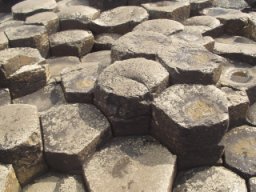Giant's Causeway: Difference between revisions
Content deleted Content added
mNo edit summary |
mNo edit summary |
||
| Line 4: | Line 4: | ||
While recent scientific research<sup>1</sup> suggests the columns were formed as a natural consequence of lava cooling, [[legend]] has it that the giant [[Finn McCool|Finn MacCumhaill]] (Finn McCool) built the causeway to walk to [[Scotland]] without having to get his feet wet. |
While recent scientific research<sup>1</sup> suggests the columns were formed as a natural consequence of lava cooling, [[legend]] has it that the giant [[Finn McCool|Finn MacCumhaill]] (Finn McCool) built the causeway to walk to [[Scotland]] without having to get his feet wet. |
||
<div style="float:right;">[[Image:Giants_Causeway0_Copyright_20030910_Kaihsu_Tai.JPG]]</div> |
<div style="float:right;">[[Image:Giants_Causeway0_Copyright_20030910_Kaihsu_Tai.JPG]]<br>[[Image:Giants_Causeway1_Copyright_20030910_Kaihsu_Tai.JPG]]</div> |
||
<div style="float:right;">[[Image:Giants_Causeway1_Copyright_20030910_Kaihsu_Tai.JPG]]</div> |
|||
==References== |
==References== |
||
Revision as of 18:03, 19 September 2003
The Giant's Causeway is a area of 40,000 basalt columns resulting from a volcanic eruption 60 million years ago. It is a World Heritage Site in Ireland and is located on the North Antrim Coast of Northern Ireland.
While recent scientific research1 suggests the columns were formed as a natural consequence of lava cooling, legend has it that the giant Finn MacCumhaill (Finn McCool) built the causeway to walk to Scotland without having to get his feet wet.
References
1 Jagla, E. A., Rojo, A. G. Sequential fragmentation: the origin of columnar quasihexagonal patterns. Physical Review E, 65, 026203, (2002) [1]



